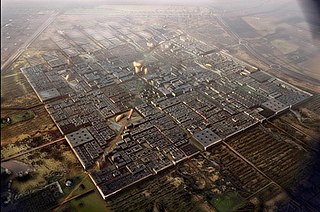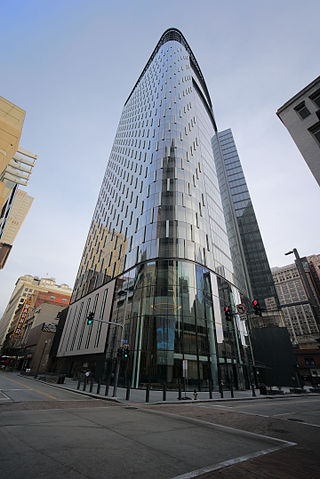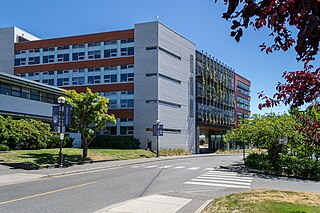
Denis Allen Hayes is an environmental advocate and an advocate for solar power. He rose to prominence in 1970 as the coordinator for the first Earth Day.

Green building refers to both a structure and the application of processes that are environmentally responsible and resource-efficient throughout a building's life-cycle: from planning to design, construction, operation, maintenance, renovation, and demolition. This requires close cooperation of the contractor, the architects, the engineers, and the client at all project stages. The Green Building practice expands and complements the classical building design concerns of economy, utility, durability, and comfort. Green building also refers to saving resources to the maximum extent, including energy saving, land saving, water saving, material saving, etc., during the whole life cycle of the building, protecting the environment and reducing pollution, providing people with healthy, comfortable and efficient use of space, and being in harmony with nature Buildings that live in harmony. Green building technology focuses on low consumption, high efficiency, economy, environmental protection, integration and optimization.’

A low-energy house is characterized by an energy-efficient design and technical features which enable it to provide high living standards and comfort with low energy consumption and carbon emissions. Traditional heating and active cooling systems are absent, or their use is secondary. Low-energy buildings may be viewed as examples of sustainable architecture. Low-energy houses often have active and passive solar building design and components, which reduce the house's energy consumption and minimally impact the resident's lifestyle. Throughout the world, companies and non-profit organizations provide guidelines and issue certifications to guarantee the energy performance of buildings and their processes and materials. Certifications include passive house, BBC - Bâtiment Basse Consommation - Effinergie (France), zero-carbon house (UK), and Minergie (Switzerland).
The Bullitt Foundation is a foundation established in 1952 by Dorothy S. Bullitt, a prominent Seattle businesswoman and philanthropist who founded King Broadcasting Company in Seattle. Its assets as of the end of 2010 were in excess of US$100M.

Leadership in Energy and Environmental Design (LEED) is a green building certification program used worldwide. Developed by the non-profit U.S. Green Building Council (USGBC), it includes a set of rating systems for the design, construction, operation, and maintenance of green buildings, homes, and neighborhoods, which aims to help building owners and operators be environmentally responsible and use resources efficiently.

A Zero-Energy Building (ZEB), also known as a Net Zero-Energy (NZE) building, is a building with net zero energy consumption, meaning the total amount of energy used by the building on an annual basis is equal to the amount of renewable energy created on the site or in other definitions by renewable energy sources offsite, using technology such as heat pumps, high efficiency windows and insulation, and solar panels.

Suzlon Energy Limited is an Indian multinational wind turbine manufacturer headquartered in Pune, India.
The 2030 Challenge is an initiative by Edward Mazria and Architecture 2030 to make all new buildings and renovations carbon-neutral by the year 2030 to avoid the catastrophic effects of climate change caused by the building sector. Buildings, construction, and operational activities generate nearly 40% of annual Greenhouse Gas (GHG) emissions, consequently, there is a larger scope to stabilize and reverse emissions in this sector, in order to avoid increased global warming to reach a tipping point. Therefore, instead of seeing it as a trying issue, Architecture 2030, a non-profit organization, strives to beat the woes of climate change by implementing energy-efficient planning and design.

Masdar City is a planned city project in Abu Dhabi, in the United Arab Emirates. Its core is being built by Masdar, a subsidiary of Mubadala Development Company, with the majority of seed capital provided by the Government of Abu Dhabi. Designed by the British architectural firm Foster and Partners, the city relies on solar energy and other renewable energy sources.

Asia Square is a retail and office building located along Marina View at Marina Bay in Singapore. It is located in Marina Bay, Singapore's new business and financial precinct. It comprises 2,000,000 square feet (190,000 m2) of office space, over 30 entertainment and dining premises, as well as the largest gym in the Central Business District.

One One One Eagle Street is a 194.7-metre (639 ft) office building at 111 Eagle Street, Brisbane, Queensland, Australia, located in the city centre. With 6 star Green Star office design rating, the building is part of the CBD's 'Golden Triangle' district. Its location is the site of the old Indigo House building, which was demolished over a period of six months starting in 2008. 95% of all waste from the old building is to be recycled or reused.
Environmentally sustainable design is the philosophy of designing physical objects, the built environment, and services to comply with the principles of ecological sustainability and also aimed at improving the health and comfortability of occupants in a building. Sustainable design seeks to reduce negative impacts on the environment, the health and well-being of building occupants, thereby improving building performance. The basic objectives of sustainability are to reduce the consumption of non-renewable resources, minimize waste, and create healthy, productive environments.

The Tower at PNC Plaza is a 33-story skyscraper in Pittsburgh, Pennsylvania. It is the corporate headquarters of the PNC Financial Services Group and has approximately 800,000 square feet (74,000 m2), standing 33 stories tall. Nearby buildings totaling 37,000 square feet (3,400 m2), were purchased by PNC and deconstructed to make space for the Tower at PNC Plaza. It is located at the intersection of Fifth Avenue and Wood Street, where PNC and its predecessors have been based since 1858.
NASA Sustainability Base is located on the campus of NASA's Ames Research Center in Moffett Field, California..It was named in recognition of the first human outpost on the mood, Tranquility Base. It was designed to exhibit and test the latest energy-saving technologies as part of the federal government's drive to eliminate fossil-fuel consumption in all new government buildings by 2030. The building was not initially conceived as a "sustainability base", but associate director Steven Zornestzer worked with architect William McDonough to create an energy-efficient building for the 21st century. McDonough, previously published "Cradle to Cradle", which argued for building architecture to move out of the "life cycle" model and become a more circular system, lasting for indefinite periods of time. This belief, along with other influences from looking at urban design and architecture through a biological perspective, provided inspiration for the NASA Sustainability Base. Energy-saving features include water recycling, fuel cell electricity generation, natural lighting, solar panels, and a geothermal well system. The building takes advantage of the sun's arc and winds from San Francisco Bay in addition to being able to adjust to changes in sunlight, temperature, wind, and occupancy. Also, the building had normal budget and actually a shorter than normal production time. One of the nation's greenest buildings, the NASA Sustainability Base was awarded the U.S. Green Building Council's Leadership in Energy and Environmental Design (LEED) Platinum status. It was completed in December 2012 and cost $27.8 million.

The Centre for Interactive Research on Sustainability (CIRS) is located at the University of British Columbia's (UBC) Point Grey Campus in Vancouver. The building is dedicated to research collaboration and outreach on urban sustainability. It was officially opened in November 2011.

The Swanston Academic building is an RMIT building designed by the architecture firm Lyons and is located on Swanston Street in Melbourne across from Peter Corrigan designed building 8 and ARM's Storey Hall. Construction began in September 2010 and was completed in September 2012. The budget for the SAB was $200,000,000. The new building contains 35,000 square metres (380,000 sq ft) of floor space, is 11 storeys high and provides 6 large lecture theatres for students. The colourful building is intended to reflect the cities surroundings in the façade. “The idea is to wear the ‘cloak’ of the city”.

The Terry Thomas Building, located in the South Lake Union neighborhood of Seattle, Washington is a sustainable, LEED-certified office building completed in 2008. The Terry Thomas is Seattle's first commercial office building structure developed in decades without central air conditioning. It was designed by Seattle-based architectural firm Weber Thompson, who also designed the interiors of the building and use it as their headquarters.

The David and Lucile Packard Foundation Headquarters is the corporate headquarters of the David and Lucile Packard Foundation, located in Los Altos, California. The Packard Foundation was created in 1964 by David Packard and his wife Lucile Salter Packard, one of the top 100 grant-making foundations in the United States, with the goals of improving the lives of children, enabling the creative pursuit of science, advancing reproductive health, and conserving and restoring the Earth’s natural systems. The David and Lucile Packard Foundation Headquarters is designed by EHDD to be the largest net zero energy building in California, and it has successfully reduced the energy use by 65% over conventional buildings.
Robert Hull was (1945–2014) was an American architect and co-founder, with David Miller, of the architectural firm Miller Hull. Hull's notable works include the Fisher Pavilion at Seattle Center and the Bullitt Center, as well as many other award-winning civic, commercial and residential buildings in the Pacific Northwest completed over a 46-year career. Hull is the recipient of multiple architectural awards, a fellow in the American Institute of Architects, and served as president of the Seattle Architecture Foundation. Under Hull's leadership, Miller Hull won the American Institute of Architects prestigious Architecture Firm Award, making it one of only two Washington state architectural firms to have earned that distinction.
















